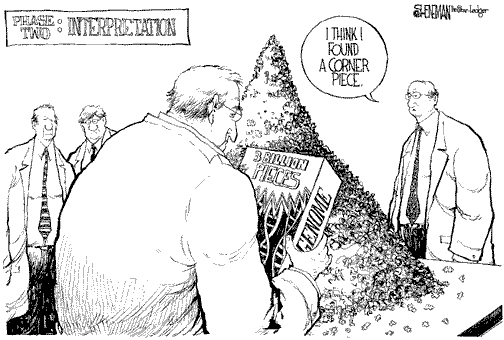I enjoyed e.g. Joe de Risi's talk on applying next-generation sequencing to diagnose the various causes of encephalitis. In the same session, Lincoln Nadauld presented clinical cases studies highlighting how exome sequencing is used to make targeted cancer treatment decisions at Intermountain Healthcare hospitals.
Themes of the technical presentations by Illumina representatives were library preparation strategies for targeted capture of specific genomic regions / transcripts of interest. Focusing on predefined subsets of sequences promises more economic use of the available reads, potentially increasing sensitivity and lowering cost at the same time.
For RNAseq applications, traditional poly-A enrichment strategies already do an excellent job at enriching for expressed exons from high-quality material. But many clinical samples suffer from RNA degradation and capturing merely the 3' tail of a transcript is not effective. As capture protocols for both DNAseq and RNAseq are adapted, there is hope to make hundreds of thousands of archived FFPE samples available for molecular analysis. At the same time, sensitive detection of tumor DNA in blood would open the door toward longitudinal data collection, e.g. following the response of patients to treatment through simple blood tests.
With ever more samples analyzed by NGS, multiple speakers pointed out that the bottleneck was not in sequencing any more, but in the subsequent computational and statistical analysis. Mike Snyder (Stanford), who presented an updated on his personal omics project , estimated that the cost of sequencing a genome was < $2,000, but the cost of analyzing > $10,000.
Plenty of room for improvement !
References:
- Actionable diagnosis of neuroleptospirosis by next-generation sequencing.Wilson MR1, Naccache SN, Samayoa E, Biagtan M, Bashir H, Yu G, Salamat SM, Somasekar S, Federman S, Miller S, Sokolic R, Garabedian E, Candotti F, Buckley RH, Reed KD, Meyer TL, Seroogy CM, Galloway R, Henderson SL, Gern JE, DeRisi JL, Chiu CY.; N Engl J Med. 2014 Jun 19;370(25):2408-17. doi: 10.1056/NEJMoa1401268. Epub 2014 Jun 4.
- Personal omics profiling reveals dynamic molecular and medical phenotypes. Chen R, Mias GI, Li-Pook-Than J, Jiang L, Lam HY, Miriami E, Karczewski KJ, Hariharan M, Dewey FE, Cheng Y, Clark MJ, Im H, Habegger L, Balasubramanian S, O'Huallachain M, Dudley JT, Hillenmeyer S, Haraksingh R, Sharon D, Euskirchen G, Lacroute P, Bettinger K, Boyle AP, Kasowski M, Grubert F, Seki S, Garcia M, Whirl-Carrillo M, Gallardo M, Blasco MA, Greenberg PL, Snyder P, Klein TE, Altman RB, Butte AJ, Ashley EA, Gerstein M, Nadeau KC, Tang H, Snyder M. Cell. 2012;148(6):1293-307. PMCID: PMC3341616.
- An ultrasensitive method for quantitating circulating tumor DNA with broad patient coverage.
Newman AM, Bratman SV, To J, Wynne JF, Eclov NC, Modlin LA, Liu CL, Neal JW5, Wakelee HA5, Merritt RE, Shrager JB, Loo BW Jr, Alizadeh AA, Diehn M.;Nat Med. 2014 May;20(5):548-54. doi: 10.1038/nm.3519. Epub 2014 Apr 6.

0 comments:
Post a Comment